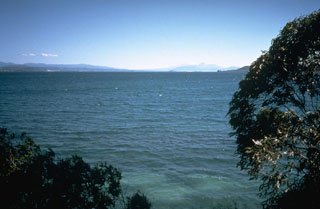Report on Taupo (New Zealand) — 14 September-20 September 2022
Smithsonian Institution / US Geological Survey
Weekly Volcanic Activity Report, 14 September-20 September 2022
Managing Editor: Sally Sennert.
Please cite this report as:
Global Volcanism Program, 2022. Report on Taupo (New Zealand) (Sennert, S, ed.). Weekly Volcanic Activity Report, 14 September-20 September 2022. Smithsonian Institution and US Geological Survey.
Taupo
New Zealand
38.7811°S, 175.893°E; summit elev. 760 m
All times are local (unless otherwise noted)
On 20 September GeoNet raised the Volcanic Alert Level for Taupo to 1 (the second lowest level on a six-level scale) reflecting “minor volcanic unrest” characterized by ongoing seismicity and inflation. Seismicity beneath Lake Taupo began increasing in May. Earthquakes occurred at a rate of about 30 per week but increased to about 40 per week in early September. A M 4.2 earthquake, the largest so far this year, was recorded on 10 September and felt by over 1,000 people. By 20 September over 700 earthquakes had been located with depths less than 30 km, though most ranged 4-13 km. The earthquake locations were in two clusters: a larger cluster beneath the central and E part of the lake, and a smaller cluster to the W centered just offshore from Karangahape. An area of deformation at Horomatangi Reef had been rising at a rate of 60 mm (plus or minus 20 mm) per year since May. The area of uplift corresponded to the main seismic swarm. The data suggested that the seismicity and deformation was caused by the movement of magma and hydrothermal fluids.
GeoNet noted that unrest at calderas was common and may continue for months or years without resulting in an eruption; more significant unrest would be indicated by additional indicators of activity and substantial impacts on the local area. There have been 17 previous episodes of unrest at Taupo over the previous 150 years, some more notable than the current episode, and many others before written records. None resulted in an eruption, with the last eruption occurring around 232 CE. The Volcanic Alert Level change was informed by ongoing analysis of monitoring data, research, and deepening knowledge of past unrest.
Geological Summary. Taupo, the most active rhyolitic volcano of the Taupo volcanic zone, is a large, roughly 35-km-wide caldera with poorly defined margins. It is a type example of an "inverse volcano" that slopes inward towards the most recent vent location. The caldera, now filled by Lake Taupo, largely formed as a result of the voluminous eruption of the Oruanui Tephra about 22,600 years before present (BP). This was the largest known eruption at Taupo, producing about 1,170 km3 of tephra. This eruption was preceded during the late Pleistocene by the eruption of a large number of rhyolitic lava domes north of Lake Taupo. Large explosive eruptions have occurred frequently during the Holocene from many vents within Lake Taupo and near its margins. The most recent major eruption took place about 1,800 years BP from at least three vents along a NE-SW-trending fissure centered on the Horomotangi Reefs. This extremely violent eruption was New Zealand's largest during the Holocene and produced the thin but widespread phreatoplinian Taupo Ignimbrite, which covered 20,000 km2 of North Island.
Source: GeoNet

